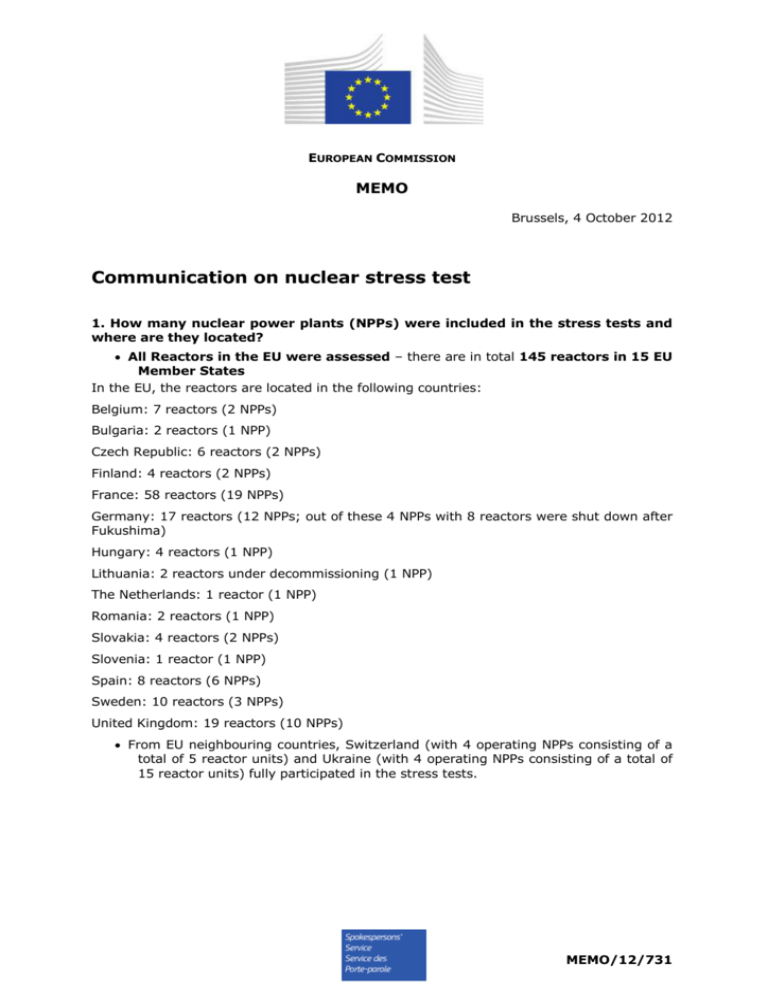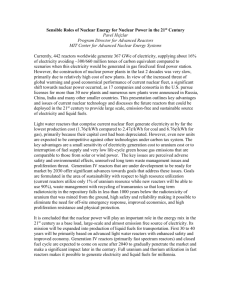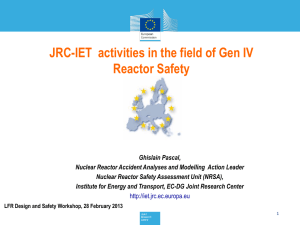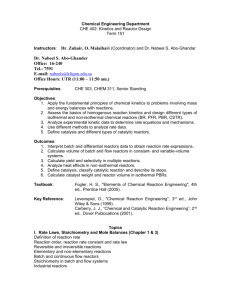DOC - Europa
advertisement

EUROPEAN COMMISSION MEMO Brussels, 4 October 2012 Communication on nuclear stress test 1. How many nuclear power plants (NPPs) were included in the stress tests and where are they located? All Reactors in the EU were assessed – there are in total 145 reactors in 15 EU Member States In the EU, the reactors are located in the following countries: Belgium: 7 reactors (2 NPPs) Bulgaria: 2 reactors (1 NPP) Czech Republic: 6 reactors (2 NPPs) Finland: 4 reactors (2 NPPs) France: 58 reactors (19 NPPs) Germany: 17 reactors (12 NPPs; out of these 4 NPPs with 8 reactors were shut down after Fukushima) Hungary: 4 reactors (1 NPP) Lithuania: 2 reactors under decommissioning (1 NPP) The Netherlands: 1 reactor (1 NPP) Romania: 2 reactors (1 NPP) Slovakia: 4 reactors (2 NPPs) Slovenia: 1 reactor (1 NPP) Spain: 8 reactors (6 NPPs) Sweden: 10 reactors (3 NPPs) United Kingdom: 19 reactors (10 NPPs) From EU neighbouring countries, Switzerland (with 4 operating NPPs consisting of a total of 5 reactor units) and Ukraine (with 4 operating NPPs consisting of a total of 15 reactor units) fully participated in the stress tests. MEMO/12/731 2. What is the danger if a nuclear power plant is hit by a tsunami or an earthquake? The reactor itself is normally well protected inside a so-called primary containment made from steel-reinforced concrete, which cannot be easily damaged by external events. In most cases, a secondary layer of containment provides additional protection to prevent releases of radioactivity to the environment. However, under conditions of extreme external impact, such as a tsunami or large earthquake, there is the risk that important safety functions of the plant could be destroyed, including the cooling and electricity supply systems. As happened in Fukushima, this could include the corresponding backup systems, thereby stopping the normal cooling functions needed to prevent the fuel inside the reactor core from becoming too hot and possibly melting. In such an accidental situation, the pressure inside the reactor containment increases and could – if not appropriately reduced – lead to explosions and possible breaks in the containment structure and consequently to releases of radioactivity into the atmosphere. Figure 1: General layout of a Boiling Water Reactor (Fukushima type) Figure 2: Flooding of the Emergency Power Supply Diesels at Fukushima 2 3. What did stress tests check? The main aim of the stress tests was 1) to assess the safety and robustness of nuclear power plants (NPPs) in case of extreme natural events (as in Fukushima) shutting down the normal safety functions of the plant, and 2) to assess the ability of the NPPs to deal with severe accidents. 4. Are airplane crashes covered? Yes. While the focus of the stress tests was on extreme natural events such as earthquakes and flooding1, other accident scenarios – extreme weather conditions or aircraft crashes – have also been taken into account to some extent. Thus, effects of airplane crashes on the safety of nuclear power plants were assessed indirectly during this review exercise. To further address the safety aspects of airplane crashes, the Commission organised on 25 September 2012 a seminar with 45 participants representing nuclear safety regulators from 18 EU Member States2, from Switzerland, the USA and Japan. New reactor designs take into account the possibility of a large aircraft crash and their containment should resist even such events. For older reactor types, alternative means of protection are used, aiming at reducing the accessibility of the NPP to approaching aircrafts and mitigating the effects in terms of large fires and explosions. Prevention and responses to incidents due to malevolent or terrorist acts are a matter of sovereign competency and were assessed in the framework of an Ad Hoc Group on Nuclear Security (AHGNS) specifically set up by the Council of the EU in July 2011. The AHGNS held thematic discussions on concrete topics, including on intentional aircraft crashes on nuclear facilities. The report of the group identifies a number of good practices to be followed by Member States. This report can be found at: http://register.consilium.europa.eu/pdf/en/12/st10/st10616.en12.pdf. 1 http://www.ensreg.eu/sites/default/files/EU%20Stress%20tests%20specifications_1.pdf 2 Including 11 of the 14 EU Member States that currently operate NPPs plus Lithuania. 3 5. How were the checks organised? Stress tests took place in the form of a three-step approach: First step – the operators performed a self-assessment and made proposals for safety improvements, following the ENSREG specifications. Second step – the operators’ assessments were reviewed by the national regulators, who also issued requirements and recommendations, Third step – a European peer review of the national reports performed by experts from nuclear and non-nuclear Member States. It assessed the compliance of the stress tests with the ENSREG specifications and checked that no important problem had been overlooked. In addition, it identified good practices, weaknesses and recommendations to increase plant robustness3. 6. Have all nuclear power plants been checked? Yes. In the first phase, all plants were assessed by their respective operators. These assessments were then checked by the respective national regulators, including on-site checks. Finally, the peer review phase covered all plants on the basis of the national reports submitted to the Commission, country presentations at the peer review meetings and additional questions to the regulators and the operators in the course of the country visits. The peer review teams visited 54 out of 145 reactors (37% of EU total), covering all the different reactor types in the EU. 7. What are the main findings of stress tests? The stress tests looked at the safety features in the light of the lessons learned from the Fukushima accident. They pointed out several areas where the highest international standards and best practices are not applied. These included: Earthquake risk: In the design of 54 EU reactor units out of 145 (37%), modern standards for earthquake risk calculation are not taken into account. The risk calculation should be based on a 10 000 year time frame, instead of the much shorter time frames sometimes used. Flooding risk: In the design of 62 reactors (43%), modern standards for flooding risk calculation are not taken into account. The risk calculation should be based on a 10 000 year time frame, instead of the much shorter time frames sometimes used. Minimum seismic hazard level: The internationally recommended minimum seismic hazard level, regardless of any lower apparent exposure to seismic hazard, has not been used for the seismic hazard studies of 65 reactors (45%). Equipment to fight severe accidents should be stored in places protected even in the event of general devastation and from where it can be quickly retrieved. This is not the case for 81 reactors (56%). On-site seismic instruments to measure and alert of possible earthquakes should be available at every nuclear power plant. These instruments should be installed or improved in 121 reactors (83%). 3 Detailed background information can be found in the stress tests reports published at the European Nuclear Safety Regulators Group (ENSREG) web page: http://www.ensreg.eu/EU-Stress-Tests. 4 After a Station Blackout, the NPP should be able to cope for more than 1 hour without intervention before safety functions need to be restored, in order to prevent reactor core heat-up. This is not the case in 5 reactors (3%). Emergency Operating Procedures should cover all NPP states (i.e. full power to shutdown states). This is not the case in 57 reactors (39%). Severe Accident Management Guidelines should be implemented and cover all plant states (i.e. full power to shutdown states). This is not the case in 79 reactors (54%). Passive measures (i.e. measures which do not require initiation by any other system or human intervention) to prevent hydrogen explosions (or of other combustible gases) in case of severe accident should be in place. This is not the case in 40 reactors (28%). Containment filtered venting systems to allow safe depressurizing of the reactor containment in case of an accident should be in place. 32 reactors do not have these systems yet (22%). Backup emergency control room should be available in case the main control room becomes inhabitable as a consequence of the radiological releases from a severe accident, of fire in the main control room or due to damage from extreme external hazards. These are not available for 24 reactors (17%). 8. What will happen? The Commission encourages all participating countries to implement swiftly the recommendations of the stress tests. National action plans with timetables for implementation will be prepared and will be made available by the end of 2012. The peer review methodology will be applied to these action plans in early 2013, in order to verify that the stress tests recommendations are consistently implemented in a transparent way throughout Europe. The Commission intends to report on the implementation of the stress test recommendations in June 2014. In parallel, the Commission has reviewed the existing European legal framework for nuclear safety and will by early 2013 propose amendments to reflect the lessons learned in the stress tests and from the Fukushima accident. Presentation of a further proposal on nuclear insurance and liability is under consideration and will follow in 2013, as well as a proposal on maximum permitted levels of radioactive contamination in foodstuffs and feeding stuffs. Strong cooperation at international level, in particular with the International Atomic Energy Agency (IAEA), is also essential. The EU should have an active role in the upcoming discussions on improving the effectiveness of the Convention on Nuclear Safety, in the framework of the IAEA. 9. Did the checks include resistance to terrorist attacks? No. Prevention and response to incidents due to malevolent or terrorist acts are not part of the mandate of ENSREG, the group of national safety authorities. Risks due to security threats were considered by the Council Ad-hoc Group on Nuclear Security (AHGNS). In contrast to the ENSREG safety assessments, the AHGNS did not look at individual installations but assessed the state of nuclear security in the EU as a whole, by looking at methodologies for the protection of NPPs, including preventive measures. 5





